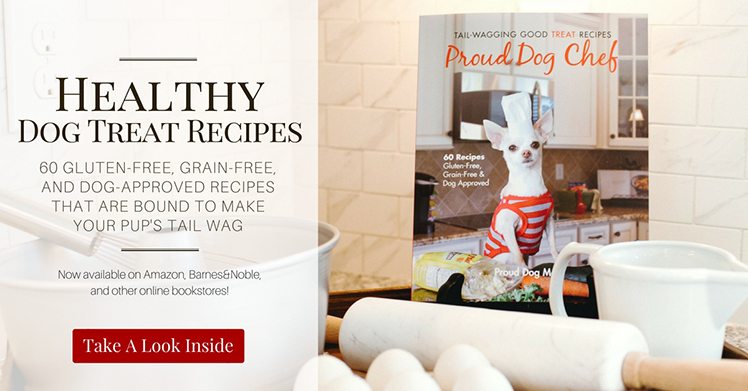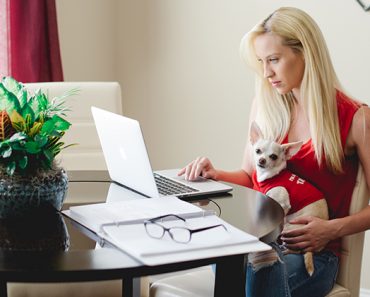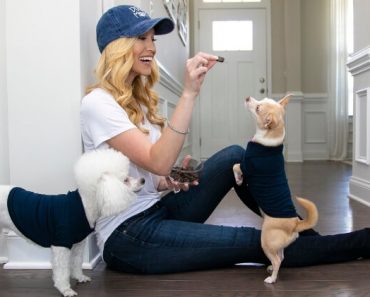You’re already an awesome dog mom and now you’re getting ready to expand your family once again. Only this time, your bundle of joy will have two legs instead of four! As you load up on the crib, bibs, and everything in between, don’t forget about Fido. While you prepare for your baby’s arrival, your dog needs to prepare too.
I recently had the opportunity to interview Dominika Knossalla-Pado, a certified dog trainer and founder of Dog Meets Baby. She works with soon-to-be parents and new parents to help safely introduce their fur babies to their human babies.

Here is Dominika’s great advice for helping your dog prepare for your new baby.
Question: Dogs thrive on consistency. But once the baby comes, there will be a lot of changes — a new family member, a lot of new baby gear around the house, and a whole new schedule. So, what’s the first piece of advice you tell soon-to-be moms?
Dominika’s Answer: Of course, I always start with ‘Congratulations!’ And then my number one piece of advice is to work on training as early as possible. Ideally, I would recommend starting by the second trimester. Once the baby arrives, you’re going to be home more, but you’re not going to be as available — especially not during the first few months.
One thing everyone should keep in mind: Once the baby comes, your full attention is on that baby, and your dog likely won’t get as many cuddles. So, start preparing your dog now by carving out alone time from your puppy.
I know it sounds horrible at first, and no pregnant mom wants to ignore their dog. But, you want to make sure there are times in the day where your dog is separated from you. When you take a shower, maybe the dog isn’t in the bathroom with you. If you take the dog for a long walk, afterward, let them take a nap in the crate while you’re in the other room.
Question: That’s great advice. For training, are there also any specific/important commands that soon-to-be moms should work on with their dogs in anticipation of the baby?
Dominika’s Answer: A lot depends on how well-trained the dog is already. Some dogs are very well trained and just need a little work, while others don’t have much training at all. But some key commands to work on:
- Go To / Place – This involves teaching the dog to go to a certain location, like a bed, mat, or crate.
- Up / Down – If the dog is allowed on the furniture, I would definitely recommend teaching the dog to move on and off the furniture when cued. So, either “Up” and “Down” or “On” and “Off”.
- Leave It – This is for all the new baby items on the floor – like the baby’s activity mat. This will also come in handy for any food dropped on the floor, or dirty diapers that are accidentally left somewhere.
- Drop It – This is useful if your dog grabs something before you’ve had a chance to pick it up. So, again, it could be a baby’s toy, bottle, or another item.
- Stay – Stay is super important! When you’re pregnant, your balance is off. So, practice “Stay” when going up and down the stairs. I like to have the dog stay at the top of the stairs while mom goes first. Then, once the baby arrives, you’ll continue to use the “Stay” command.

Also, don’t only practice giving commands when you’re standing right in front of the dog. Because most dogs can easily pick up on cues when you’re right in front of them. But, when you have a baby, you’ll be giving the cues from another room, while sitting on the floor, or when your hands are full with the baby and a bottle. So, it’s important for you to have a well-trained dog that will take cues when you’re not standing in front of them.
Question: This brings up an interesting point. While a lot of people train using verbal cues, many also rely on hand signals and physical cues to communicate with their dogs. So, it sounds like even well-trained dogs may need some re-training!
Dominika’s Answer: Yes, 100%. Because, as you said, you can use your finger to point now, but, oftentimes, once the baby comes, you won’t have that hand available to point. It’s good to have the verbal cues down.
Question: What are some beneficial socialization tips for dogs who don’t have any experiences with babies or little kids?
Dominika’s Answer: That’s a great question. The last thing you want to do is bring your dog to a kid’s two-year-old birthday party and then the poor dog is overwhelmed by all the attention and touching. That could actually lead a dog to dislike kids later on. So, you want to really go slowly.
At first, I would not seek out kids and ask them to pet your dog. Instead, go to a nearby playground and, as your dog watches the kids running and playing, give a treat. You want to create a positive association with children.
Then, if you have a friend with little kids, you can ask them to help. I like to use the bubble analogy with kids. The dog is in the bubble — you’re not going to go into her bubble, but she can come out of it. Here’s what you could say: ‘I’m going to hang out with my dog over here and give her some treats. You’re going to play over there, you can wave at her or blow kisses but we are going to see if she comes out of her bubble and approaches you.’
Just make it a positive experience. If you see your dog has a hard time then add more distance and maybe introduce better treats.

Question: Since there will be a lot of schedule changes once the baby comes, should soon-to-be moms predict and practice routine changes?
Dominika’s Answer: It’s not so much that you have to change your schedule, but you should start planning for things that will be harder for you. For example, exercising your dog.
You don’t want to go from taking hikes every weekend to the dog being stuck at home with no exercise. Dogs need exercise. So, if you’re going to have a family member stay with you after the baby arrives then maybe that family member can be responsible for taking the dog for walks. Or maybe a neighbor wants to help out. If not, there are daycares and professional dog walkers, if that’s in your budget.

Question: Now, let’s chat about baby gear. Do you have any special tips for introducing dogs to all the new stuff, especially things that move and make noise?
Dominika’s Answer: Some dogs are very sensitive to change. I would definitely rearrange furniture early on because I’ve had people tell me, ‘I bought a new dresser and the dog freaked out. Doesn’t walk in the room anymore.’ If you have a dog like this, I would take the time to show them any equipment that takes up space, makes a sound, or has moving parts.
For anything that moves, some dogs will try to grab it with their mouth or just bark at it. So, go slow. Here is one of the ways you could introduce it:
The first day, just bring the item out and set it on the floor for your dog to sniff. The goal for your dog is to be comfortable with the new item and ignore it. Next, with your pup at a distance, give your dog something yummy to chew or some treats, right after you turn it on briefly. Repeat this until your dog gets comfortable!

Question: If someone doesn’t already have one, what are your thoughts about setting up a special area for the dog?
Dominika’s Answer: Yes, 100%. Set up a no-baby zone where your dog can feel safe and calm. Alone time – since most little kids sleep in the parents’ bedroom – is often a crate or a comfy bed in a part of the house where the baby doesn’t sleep or hang out during the day.
Question: When would you recommend people work with a professional trainer?
Dominika: A lot of people reach out to me later when there’s a problem. And, usually, the problem has become so painful and the new parents don’t have that much time, energy, or patience to work on it. It’s better to be proactive, if possible.
While you can definitely watch obedience training classes online, working with a professional trainer means lessons are going to be tailored to your family’s needs.
When I work with families, I usually go to the house, see where they live, check out their setup, ask them questions, and address everything unique to them. It can feel a little nosy at times. But I really need to know details like their schedule, how much training the dog already has, where the dog sleeps, if the dog barks at the mother-in-law, etc. And I give them a very detailed plan for them to follow. Then we do follow-ups.
Right now, I’ve been doing these training sessions on Zoom because of COVID. But everything else is the same – I ask many questions and they still show me around their house, on Zoom or Facetime.
A Little About Dominika & Dog Meets Baby

Dominika is a certified dog trainer and mom to 4-year-old twins and fur baby, Lola. She helps fellow parents prepare their pups for the arrival of their baby, as well as safely introduce the new family member to their doggie sibling. Adding a child to the mix creates a whole new dynamic and can be challenging. Dominika’s mission at Dog Meets Baby is to give parents practical solutions to create a safe and happy bond between their children and dogs.








